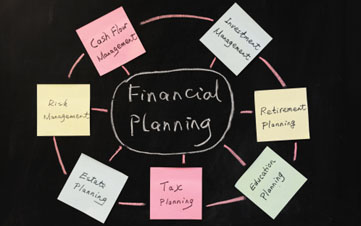The 7 Deadly Sins of Investing
You’ve probably heard of the seven deadly sins.


You’ve probably heard of the seven deadly sins. In traditional moral teachings, these transgressions -- wrath, greed, sloth, pride, lust, envy and gluttony -- are human tendencies that, if not overcome, can lead to other sins and a path straight to the netherworld.
The investing world has its own set of deadly sins. These attitudes, approaches, actions and omissions can hurt results, and they compound the damage by leading to other transgressions. To be a better investor, recognize these missteps and learn how to overcome them.

Following the Herd
Following the herd works when you shop for a product. A car or washing machine that’s performed well in the past is likely to excel in the future. The opposite is often true in finance. What’s hot today is likely to be cold tomorrow, and vice versa.
In fact, the herd tends to gather the most strength right before the investment it is chasing goes off a cliff. Ill-timed moves in and out of funds, sectors and markets go a long way toward explaining why the performance of fund investors is decidedly poorer than the reported results of their funds. For example, over the past 15 years, investors in U.S. stock funds earned an average of 2.3 percentage points per year less than the funds themselves, says Morningstar.
Redemption: Follow rules, not herds, suggests Bill Allen, vice-president of the private client advisory group at Charles Schwab. These rules can be as simple as refusing to buy or sell in response to news reports, or making sure you invest the same amount every month no matter what the market is doing. Resisting the urge to follow the crowd can prevent you from committing the sin of buying high and selling low.

Giving in to Fear
What the typical investor sees as risk is merely volatility, normal day-to-day swings in the market. Although volatility can be frightening, the real danger lies in being too afraid of risk: You lose buying power -- permanently.
For example, suppose you invest in a Treasury security or bank account that pays 0.5% annually. With inflation at 2% today, you’ll actually lose 1.5% per year in buying power. The loss will be greater if inflation reverts to its long-term average of 3% per year. If inflation clocks in at its historical average, items that cost $1 today will be $2.43 in 30 years. But if you earn only 0.5% a year, you’ll have just $1.16 to pay for them. That’s a 52% loss in buying power.
- Redemption: Put the stock market’s day-to-day volatility out of your mind and focus on the long term. Since 1926, U.S. stocks, as measured by Standard & Poor’s 500-stock index, have returned nearly 10% a year. Even if you had invested in the market at the March 2000 peak and held on through two horrific bear markets, you would have earned 3.4% annualized -- not great, but not disastrous, either. In other words, the stock market is the place to invest your long-term money.

Hanging on Too Long
Knowing when to sell is hard. One reason selling is so tough is that you become psychologically invested in something once you buy it. If you own a winner, you may be reluctant to part with it because it’s been so good to you, so you hold on regardless of how overpriced it may be. If you own a lemon, you may not want to sell because doing so would leave a sour taste by confirming your stupidity.
- Redemption: You need to have a sell strategy, says Jeff Saut, chief investment strategist at Raymond James Financial. For starters, be sure to review your investments at least once a year. If you own a stock, ask yourself whether, given all you know about the company, you’d buy it at today’s price. If not, consider selling all, or at least a portion, of the holding. You could base sell decisions on value-oriented measures. Start trimming a position if a stock approaches your price target or if its price-earnings ratio exceeds a predetermined benchmark. Or consider using stop-loss orders, which trigger a sale when a stock’s price falls to a set threshold.
Fund investors must weigh other factors. The departure of a key manager can be a signal to sell. So can a change in a fund’s basic strategy. And if a fund consistently does worse than a key index or category average, it’s always a cause for concern -- although just about all funds go through tough stretches. (For more, see When to Sell a Mutual Fund.)

Neglecting to Rebalance
One of the best ways to manage risk is to diversify: to own investments in a variety of categories, including domestic stocks, foreign stocks, bonds, and perhaps real estate and commodities, such as oil and precious metals. In building a well-diversified portfolio, you normally assign a weighting to each investment category -- for example, 50% in U.S. stocks, 30% in foreign stocks and 20% in bonds. The right mix is a function of your goals, time horizon and tolerance for risk.
But because the performance of different investments varies, a portfolio can quickly get out of balance. Letting a portfolio get too far out of whack increases risk and means your investments are less likely to adequately meet your goals, says Stuart Ritter, a financial planner with T. Rowe Price.
- Redemption: Although it’s counterintuitive, the wise investor sells some winners and buys some of the losers at least once a year. This process, known as rebalancing, aims to keep your asset mix where you wanted it when you started. Rebalancing forces you to add to investments that are relative laggards and to sell those that are performing well relative to your other investments.

Making Things Complicated
The more securities you own, the more likely your portfolio will perform like an index fund, rising and falling in lock step with the market as a whole. And by building a vast portfolio piece by piece, you will increase your trading costs and be forced to follow and research more securities than your time, energy and ability permit.
One of Warren Buffett’s dictums is to “never invest in a business you can’t understand.” Most investors are better off staying away from options, principal-protected notes and funds, funds that seek to double or triple an index’s gains, and funds that track obscure volatility indexes.
- Redemption: Make sure you understand how your investments work and why each is in your portfolio. Put the bulk of your long-term money in a handful of low-cost funds. You can create a portfolio with funds in the Kiplinger 25 (see Our 25 Favorite Mutual Funds, and Top Performing Mutual Funds tool. If you prefer index funds, see the portfolios in How to Pick the Best Index Funds. You can also buy funds that adjust their asset mix to become increasingly conservative as time goes on (see Pick the Best Target-Date Fund for You).
If you choose to own individual stocks, limit yourself to a relative few—no more than 20—that you understand and feel comfortable tracking on a regular basis. And beware of derivatives, which Buffett has called “financial weapons of mass destruction.”

Paying Too Much in Fees
Small differences in fees can have a big impact. Say you start with $10,000 and invest $500 a month for 30 years. If you invest in an index fund that charges just 0.2% each year and the fund returns 8% a year before fees, your account will grow to $818,639. If you buy a fund that charges 1.2% annually, however, you’ll net $662,916 -- almost $156,000 less.
Stock pickers should also pay attention to costs. Consider an active investor who makes one trade per week. If he uses a full-service broker, such as Merrill Lynch, and pays $75 per trade, he’ll pay $3,900 a year. The same moves made with a discount broker charging $10 per trade would cost $520 per year. Over 30 years, assuming that the savings are invested and earn 8% a year, the extra cost of the full-service broker would amount to $400,000.
- Redemption: Stop looking at trading costs as one-time events, and recognize the long-term impact they can have on your portfolio. Trade sparingly and compare costs before you invest.

Failing to Stick to a Plan
The greatest investment sin of them all is failing to formulate and follow a plan. After all, the main purpose of investing is to generate the wherewithal to get something, or many things, that you want in the future. Without a plan, it’s impossible to know whether you’re on the right track.
- Redemption: Start by jotting down your goals, from short-term wants, such as buying a house or a car, to long-term aims, such as paying for your kids’ college and financing a comfortable retirement. Determine the time horizon for each goal and estimate its cost. Then match short-term goals with short-term investments, such as bank accounts and Treasury bills. Match medium-term goals with somewhat more-aggressive investments, such as long-term CDs, intermediate-term bonds and a bit in stocks.
Finally, put your long-term investments in stocks and stock funds, both domestic and foreign. Check on your portfolio (and your financial plan) at least once a year to make sure that you’re still on track and that you like the direction you’re headed. (If you need help with setting goals or determining what they might cost, as well as with investing, check out Pick the Right Money Manager.)

More From Kiplinger
SLIDE SHOW: The Dow 30 -- Which Stocks to Buy, Hold or Sell
SLIDE SHOW: 8 Ways to Profit From Dividend Stocks
Get Kiplinger Today newsletter — free
Profit and prosper with the best of Kiplinger's advice on investing, taxes, retirement, personal finance and much more. Delivered daily. Enter your email in the box and click Sign Me Up.

-
 How Baby Boomers and Gen Xers Are Redefining Retirement Living
How Baby Boomers and Gen Xers Are Redefining Retirement LivingBoth generations need to embrace change and leverage real estate as a dynamic asset in their retirement planning. Here's how financial advisers can help, too.
By David Conti, CPRC Published
-
 How Good Advisers Manage Risk in Challenging Markets
How Good Advisers Manage Risk in Challenging MarketsThey understand the difference between what might be real challenges to an investor's strategy and fear brought on by market volatility.
By Ryan L. Kirk, CFA® Published
-
 The Cheapest Places To Retire in the US
The Cheapest Places To Retire in the USWhen you're trying to balance a fixed income with an enjoyable retirement, cost of living is a crucial factor to consider.
By Stacy Rapacon Published
-
 Can Stocks Picked by Artificial Intelligence Beat the Market? 3 Stocks to Watch
Can Stocks Picked by Artificial Intelligence Beat the Market? 3 Stocks to Watchstocks An artificial intelligence stock-picking platform identifying high-potential equities has been sharp in the past. Here are three of its top stocks to watch over the next few months.
By Dan Burrows Last updated
-
 5 Stocks to Sell or Avoid Now
5 Stocks to Sell or Avoid Nowstocks to sell In a difficult market like this, weak positions can get even weaker. Wall Street analysts believe these five stocks should be near the front of your sell list.
By Dan Burrows Published
-
 Best Stocks for Rising Interest Rates
Best Stocks for Rising Interest Ratesstocks The Federal Reserve has been aggressive in its rate hiking, and there's a chance it's not done yet. Here are eight of the best stocks for rising interest rates.
By Jeff Reeves Last updated
-
 The 5 Safest Vanguard Funds to Own in a Volatile Market
The 5 Safest Vanguard Funds to Own in a Volatile Marketrecession The safest Vanguard funds can help prepare investors for continued market tumult, but without high fees.
By Kyle Woodley Last updated
-
 The 5 Best Inflation-Proof Stocks
The 5 Best Inflation-Proof Stocksstocks Higher prices have been a major headache for investors, but these best inflation-proof stocks could help ease the impact.
By Louis Navellier Published
-
 5 of the Best Preferred Stock ETFs for High and Stable Dividends
5 of the Best Preferred Stock ETFs for High and Stable DividendsETFs The best preferred stock ETFs allow you to reduce your risk by investing in baskets of preferred stocks.
By Kyle Woodley Last updated
-
 What Happens When the Retirement Honeymoon Phase Is Over?
What Happens When the Retirement Honeymoon Phase Is Over?In the early days, all is fun and exciting, but after a while, it may seem to some like they’ve lost as much as they’ve gained. What then?
By T. Eric Reich, CIMA®, CFP®, CLU®, ChFC® Published
